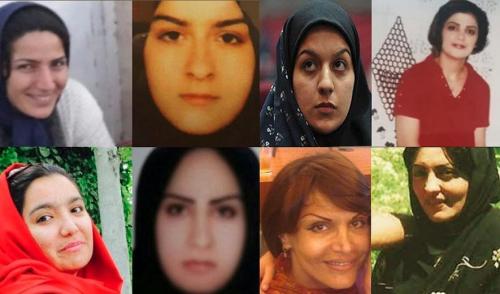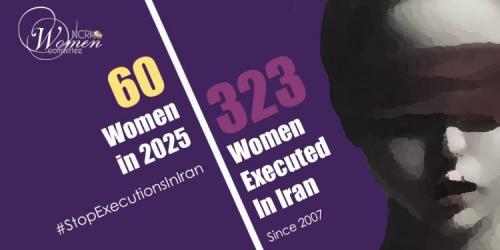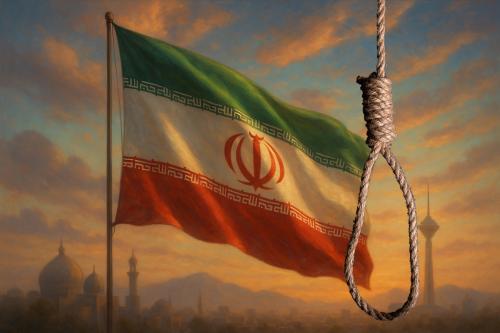11 October 2021 :
Women and the Death Penalty in Iran: a 12 Year Analysis.
The 2021 World Day Against the Death Penalty is dedicated to women; those who risk being sentenced to death, who have received a death sentence, who have been executed, and to those who have had their death sentences commuted, exonerated, or pardoned. In observation of the day and the theme this year, Iran Human Rights is providing a report on the women executed in Iran over the last 12 years (2010-2021). The executions in this period are by no means representative of the Islamic Republic of Iran’s complete history of executing women; the number of female political prisoners executed in the 1980s must be acknowledged due to their sheer volume and abhorrent nature. But even today, there is ample evidence of their cruel and inhuman treatment of female prisoners, which will be highlighted in this report.
Today, Iran has the highest number of executions after China, and is one of the world’s top executioners of women. Of the 16 women reported to have been executed globally in 2020, nine were executed in Iran. As with all executions, the majority of women executions are carried out secretly. When reported, women are often portrayed as evil mothers, femme fatales and witches. The reality however is layered with legislative and social discrimination, inequality and taboos, which this report aims to examine.
On the occasion of the World Day Against the Death Penalty 2021, IHR repeats its call for Iran to establish a moratorium on the use of the death penalty as a first step towards the abolition of the death penalty, and for women to be entitled to equal civil rights and equality before the law. Mahmood Amiry-Moghaddam, IHR Director said: “In 2021, the world should not tolerate laws that legitimise the death penalty, which is the most cruel, inhumane and discriminatory punishment of our time. This World Day Against the Death Penalty, let us be the voice of the women on death row who are mostly unknown and from marginalised backgrounds.”
Facts and figures:
The following statistics relate to the execution of women recorded by Iran Human Rights between 1 January 2010-10 October 2021;
At least 164 women were executed;
Female executions represent 2.57% of all executions in the same period;
31% (51) of the executions were announced by official sources and 69% (113) were carried out secretly or not announced;
At least 86 women were executed on drug-related charges;
At least 60 women were executed on murder charges;
Of the three women executed on security charges, two were executed on espionage charges;
The third woman (Shirin Alamhooli), was executed on the charge of moharebeh (enmity against god) for membership in a Kurdish opposition group;
The charges against 15 of the women are unknown;
3 of the executed women were juvenile offenders;
1 woman (Zahra Bahrami) was executed on drug-related charges after being arrested in relation to the 2009 protests and originally sentenced to moharebeh (enmity against god).
Background.
The context and background of female executions in Iran must be examined through the legislative framework of the death penalty in general, and of the breaches of rights and social issues faced by women specifically. A comprehensive report on the death penalty in Iran is published annually by Iran Human Rights and ECMP (Together Against the Death Penalty), which provides a detailed breakdown of the legislative framework and procedures. A more condensed version relating to the execution of women in this period is provided for the purpose of this report.
The death penalty is sanctioned for a number of crimes which cannot be considered “most serious crimes” and do not meet the provisions of the International Covenant on Civil and Political Rights (ICCPR), ratified by Iran in 1975. Of the cases recorded in 2010-2021, all but two (espionage) of the known charges against the164 women were for drug-related offences and murder. Once arrested, confessions are the most common way of proving guilt in death penalty cases. Furthermore, in qisas cases, a woman’s testimony is considered worthless and they are not entitled to be witnesses. All death row prisoners IHR has been in contact with have testified to being subjected to torture in order to confess to the crime they were charged with. This is not limited only to those with political or security-related charges. Almost all prisoners who were arrested for drug-related offences have been kept in solitary confinement and subjected to physical torture in the investigation phase following their detention, while being denied access to a lawyer. In many cases, confessions extracted in detention have been the only evidence available for the judge to base his verdict upon. Torture is also used in other criminal cases involving rape or murder where there is not enough evidence against the suspect.
The important point to note is the systematic denial of legal due process, unfair trials, use of torture and duress, forced confessions and lack of a transparent and independent judiciary in Iran. The charges in each case, therefore, are the official account and charges by Iranian authorities, and have not been confirmed by independent sources.
Women also face inequality before the law and societal discrimination prior to having committed any crimes. As with global statistics, poverty is an underlying factor in death penalty cases. This is particularly evident in drug-related executions but also extends to murder cases. Traditionally, men are considered the breadwinners and when working class women who were not afforded an education or professional skills are left to raise their children alone, without any support from the state, they are forced to do what they can to survive. When a single mother of five, including a disabled child, was executed on drug-related charges, her family could not even afford to bury her. And her case is by no means isolated or unique.
Societally, women also face forced marriages; six child brides were amongst the women executed in 2010-2021 and one woman (Safieh Ghafouri, charged with murder) was an aroose-khoon-bas, a bride offered by one tribe to the opposing tribe to stop the bloodshed. Within the marriage itself, a woman does not have the right to divorce, even in cases of domestic abuse, which are hidden in cultural codes and language. In 66% of the known murder cases, the women were convicted of killing their husband or partner. Mental illness also remains a taboo subject, with inadequate care and treatment within Iranian society at large.
Qisas executions
Qisas or retribution-in-kind is the right of the murder victim’s family according to the Islamic Penal Code. The State effectively puts the responsibility for executions for murder in the hands of the victim’s family to decide whether they want retirbution, diya (blood money) or to forgive. Qisas death sentences are also imposed for juvenile offenders as, according to Sharia law, the age of criminal responsibility for girls is 9 and for boys 15 lunar years (8.7 years for girls and 14.6 years for boys);
60 women were executed on murder charges in 2010-2021;
Murder charges account for more than 90% of all female executions since 2018;
Of the 60 executions, the details of 41 of the cases have been established and 19 are unknown;
66% of the 41 women were charged with the murder of their husband/fiancé/lover/temporary marriage;
6 of the women were child brides;
3 were under 18 years of age at the time of committing the alleged murder (juvenile offenders);
2 suffered with confirmed mental illnesses;
3 of the women had committed murder in self-defence against rape;
1 of the women was an aroose-khoon-bas.
Cases:
Reyhaneh Jabbari, 26, was sentenced to qisas after being convicted of killing a man in self-defence against rape. She was tortured to make self-incriminating confessions but later published her account of the event from prison. She was executed on 25 October 2014.
Zeinab Sakamvand was a child bride and a juvenile offender who was also a victim of domestic abuse and of rape by her brother-in-law. She was accused of killing her husband at 17, which she denied. She married another prisoner in prison and gave birth to a stillborn child prior to her execution on 2 October 2018.
Zeinab Khodamorad, 43, suffered from acute mental illness and was hospitalised following the birth of her child. She killed her child and stepchild after her husband discharged her against hospital advice. She was executed on 29 December 2020.
Maryam Karimi, was a victim of domestic abuse, but her husband refused to consent to a divorce. She was on death row for 13 years with her father, Ebrahim Karimi, who helped her kill her husband. Her execution was carried out by her own daughter and her father was brought in to see Maryam’s dead body hanging on the noose on 15 March 2021.
Drug-related executions.
A new amendment to the Anti-Narcotics law came into force on 14 November 2017 which included a mechanism to limit the use of the death penalty. Prior to this, drug charges counted for the majority of female executions in Iran. The amendment led to a significant drop in the number of drug-related male executions, and a complete decline in female executions until 30 May 2021, when a woman was executed in Qazvin Central Prison.
Drug-related executions are dominated by underlying poverty issues.
Cases:
Hourieh Sabahi, a 35-year-old single mother of 5, including one disabled child and Roghieh Khalaj, a 32-year-old single mother of 2, were executed on drug-related charges in Hamedan Central Prison in October 2011.
Zahra Bahrami, a 46-year-old dual national protester arrested in the aftermath of the 2009 nationwide protests, was originally sentenced to moharebeh (enmity against god) but was later tortured to confess to drug-related charges in a fabricated case that ended with her execution on 29 January 2011.
Political executions.
Security charges that carry the death penalty include moharebeh (enmity against god), efsad-fil-arz (corruption on earth), baghy (armed rebellion) and espionage. The vague charges under the jurisdiction of the Revolutionary Courts are often used against political prisoners.
Cases:
Shirin Alamhooli, 28, was arrested in 2008 and sentenced to moharebeh (enmity against god) for membership in PEJAK, a Kurdish opposition group by the Revolutionary Court. She did not speak Farsi at the time of her interrogation and legal proceedings. In letters from prison, she described three months of physical and mental torture. Shirin was secretly executed in Evin Prison on 9 May 2010.
What can be done:
Enforce a moratorium on the use of the death penalty in order to work progressively towards abolition.
Removal of all discriminatory laws against women to ensure due process and equality before the law and grant women the right to equal divorce
Impose a ban on child marriages
Provide legal protections against domestic abuse and violence against women.
Other NGOs of Iranian exiles operating from abroad have launched appeals similar to that of IHR. For example, Iran Human Rights Monitor (Iran HRM) has appealed to the international community to pressure to pressure the Iranian regime to stop their common use of the death penalty, especially against women, and to annul all related decrees. It further called the attention of the international community to the deplorable situation of women on death row in Iran.
Iran Human Rights | Article: Women and the Death Penalty in Iran: a 12 Year Analysis | (iranhr.net)
On World Day Against Death Penalty call for stop execution of women in Iran (iran-hrm.com)








